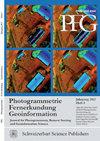用于考古勘探的TerraSAR-X后向散射图像视觉分析
Q Social Sciences
引用次数: 1
摘要
卫星雷达的使用极大地扩大了考古勘探的可能性。然而,到目前为止,可用传感器的分辨率非常有限,只能探测到巨大的直立纪念碑或文化景观。然而,2007年发射的德国雷达卫星TerraSAR-X现在提供了高达1米的分辨率,这是探测小型考古遗迹所需的最低分辨率。尽管直立的纪念碑可以清晰地辨认出来,但TerraSAR-X所使用的高频x波段波是否能穿透土壤,并提供埋藏考古的信息,仍然是不确定的。本文给出了叙利亚和意大利两个试验场的试验结果。两者的共同之处在于,都有广泛的地面地球物理调查,利用磁强计和探地雷达,提供有关埋藏考古遗迹的信息。通过将这些结果与TerraSAR-X数据进行详细的目视比较,我们可以证明存在几厘米的轻微穿透深度。本文章由计算机程序翻译,如有差异,请以英文原文为准。
Visual Analysis of TerraSAR-X Backscatter Imagery for Archaeological Prospection
The use of satellite radar widens the possibilities of archaeological prospection extremely. The resolution of the available sensors however was quite limited until now and only the detection of huge upstanding monuments or cultural landscapes was possible. The launch of TerraSAR-X, a German radar satellite in 2007, however, now offers a resolution of up to 1 m, which is required as a minimum for detecting small archaeological remains. Whereas upstanding monuments are clearly identifiable, it was still uncertain, whether the used high-frequency X-band waves of TerraSAR-X could penetrate the soil and provide information on buried archaeology as well. This paper shows the results of two test sites in Syria and Italy. Both of them have in common that there are extensive surveys by ground-based geophysical surveys with magnetometry and ground-penetrating radar, which provide information on the buried archaeological remains. By a detailed visual comparison of these results with the TerraSAR-X data, we can prove that there is a slight penetration depth of a few decimetres.
求助全文
通过发布文献求助,成功后即可免费获取论文全文。
去求助
来源期刊

Photogrammetrie Fernerkundung Geoinformation
REMOTE SENSING-IMAGING SCIENCE & PHOTOGRAPHIC TECHNOLOGY
CiteScore
1.36
自引率
0.00%
发文量
0
审稿时长
>12 weeks
 求助内容:
求助内容: 应助结果提醒方式:
应助结果提醒方式:


